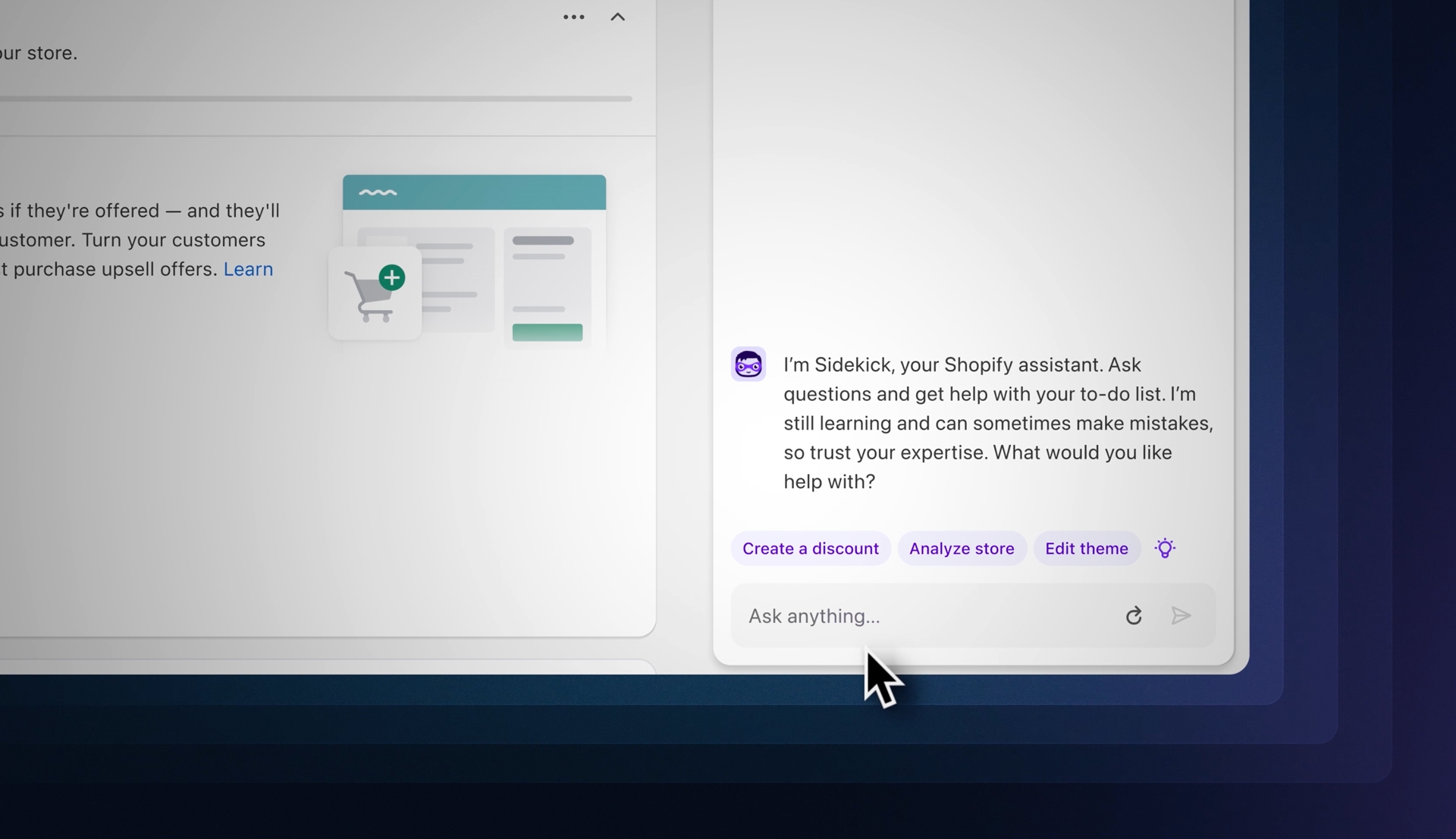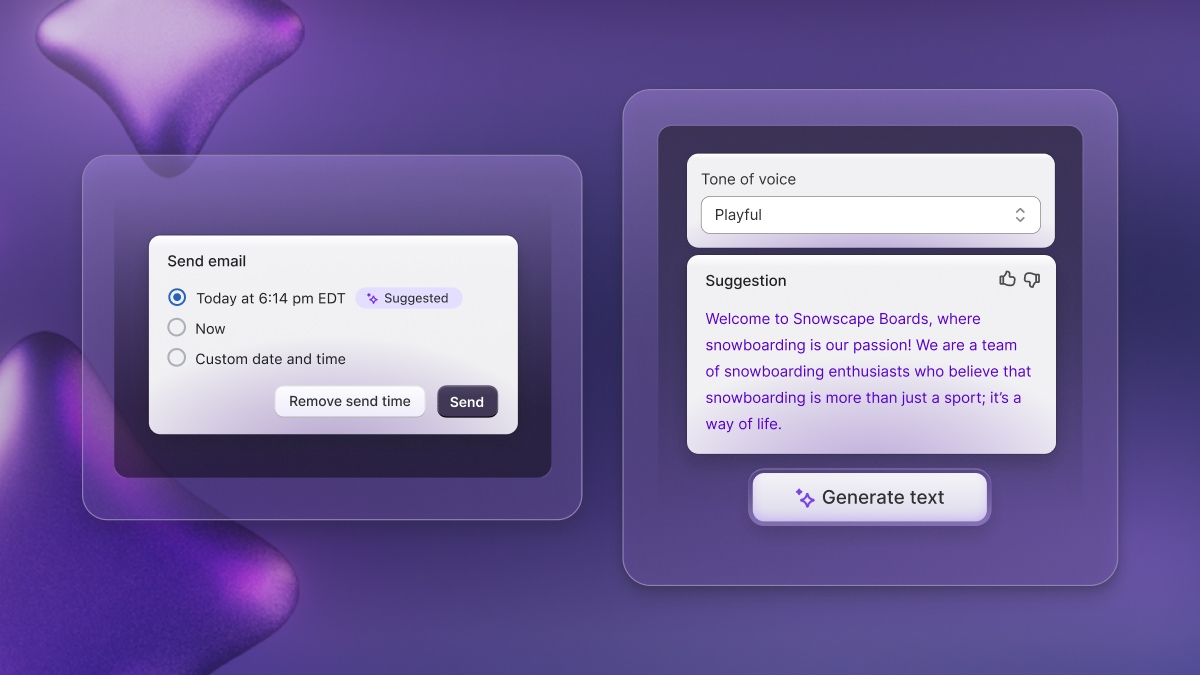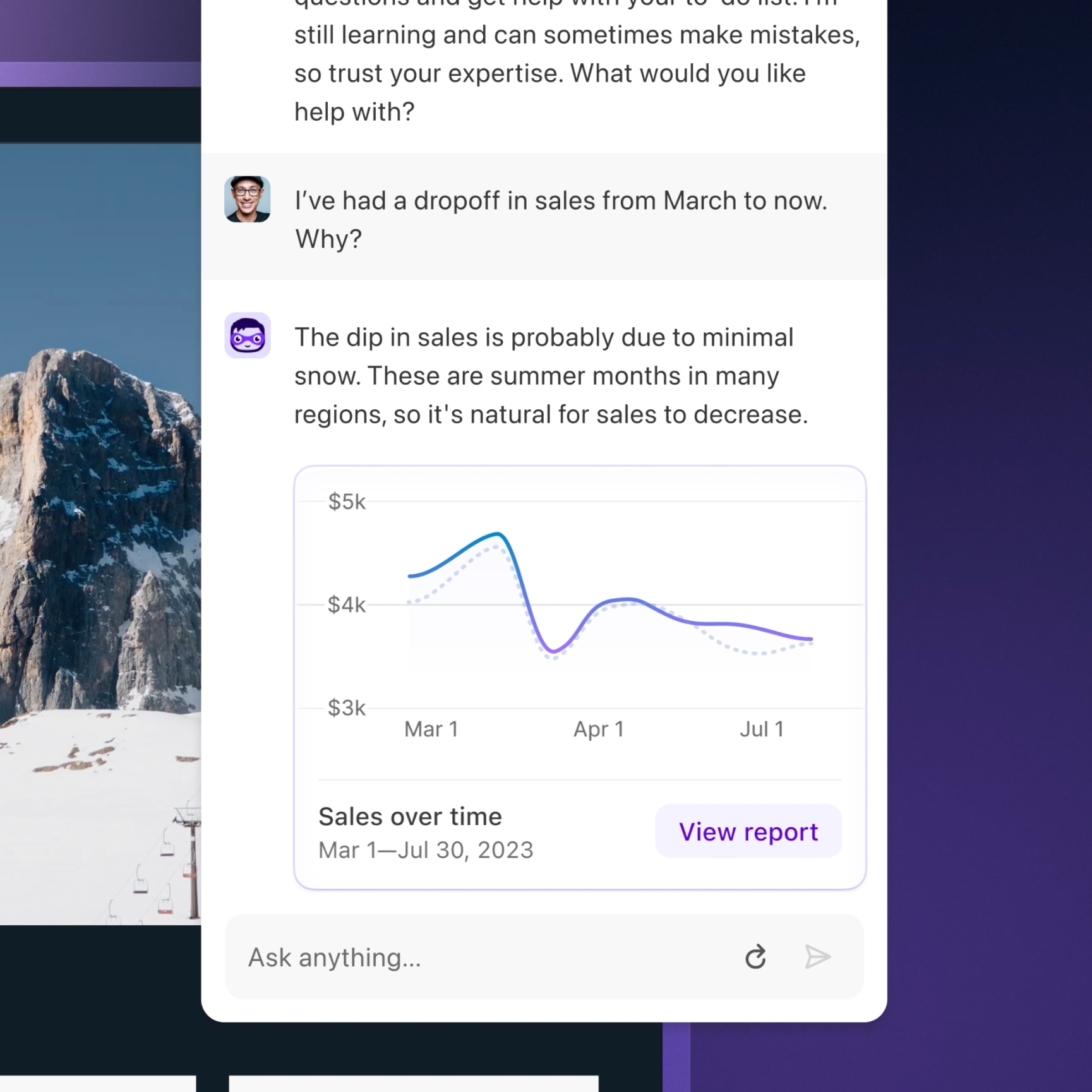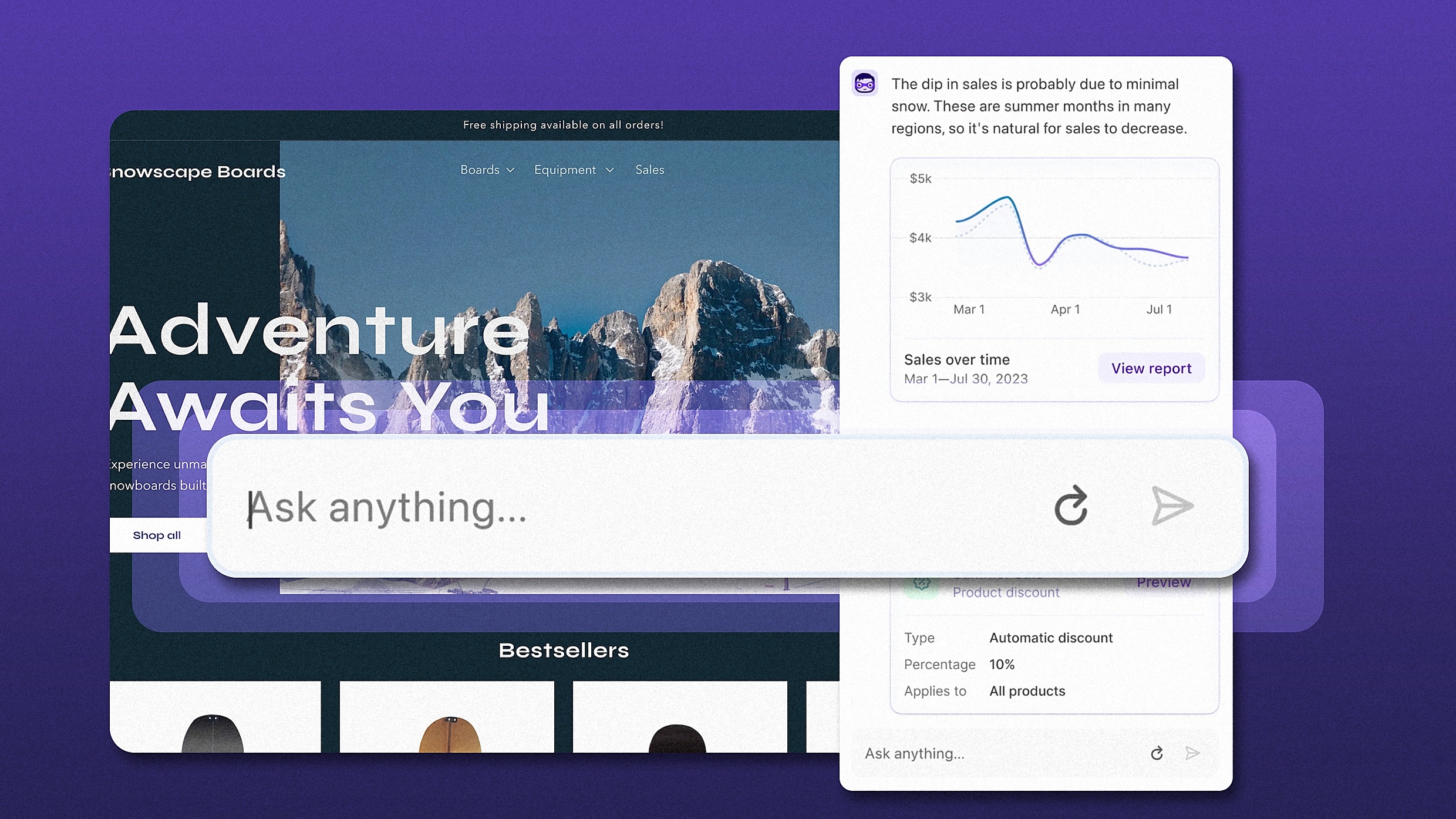Shopify’s magical Sidekick AI is a harbinger of design’s inevitable reckoning
In its quest to become the anti-Amazon, Shopify has long used machine learning to detect fraud, analyze data, and compare competing merchants. But now, like other big names in the industry—from comprehensive website builder Wix to content-creation-wizard Canva to professional design tool Figma—Shopify is going all-in on generative AI.
Each platform is taking a different approach to AI, but they have the same basic objective: let their users do more in less time, and without the required knowledge of how to design, code, or even strategize.
Over the last year, generative AI has become a democratizing force when it comes to accessing the power of complex software tools. It’s killing the imperative interfaces, which once required users to navigate through endless menus, and replacing them with declarative interfaces, which allow users to ask for exactly what they want in natural language.
Shopify’s founder and CEO Tobi Lütke declared that ambitious goal last week in a video presentation of Sidekick, the company’s new AI chat agent that has been designed to copilot Shopify users’ businesses. Sidekick is meant to act as advisor, shop clerk, shop designer, shop manager, and content creator, all the while learning constantly from its performance and its human boss’ actions and responses.

“When ChatGPT came out, we saw it was the right time to give this power to our users,” says Miqdad Jaffer, Shopify’s director of product. Jaffer saw generative AI as a way to simplify users’ daily operations on the platform while helping them generate content more quickly. “When we started looking into [integrating AI], we concluded that everything is content. Media is content, code is content,” he says.
Jaffer and his team quickly realized that to make AI truly useful to Shopify’s 2 million-plus users, it would need to be integrated into the platform in a way could cohesively handle the many administrative moments small-business owners encounter on a daily basis. “[It needed to be] something that wasn’t just in a couple places, but was everywhere that the merchant needed,” he says.
Over the years, Shopify built a strong interface with a robust feature set. But the platform can also be hard to parse without some practice. “What if we move toward a declarative interface, one in which the merchant could just ask for what they wanted and the system would comply?” Jaffer says.
From Clippy to Sidekick
The answer was Sidekick. Sidekick is part of Shopify Magic, a suite of AI features integrated across the platform that automate tasks like writing product descriptions. Shopify began rolling out its Magic features in April, but Sidekick is the centerpiece of the company’s bigger push into AI. Alongside Sidekick, today Shopify is announcing a tool that “can instantly generate blog posts for any holiday, business milestone, or campaign idea, with the ability to customize tone of voice.” There’s also a new Shopify Magic tool that can turn a few words into email newsletters and announcements. It can even automagically recommend the best time to send each newsletter to drive higher click-through rates to the store based on the data it has around the merchant, its market, and customer geography.
According to Jaffer, Sidekick was designed to handle the niggling tasks that eat up so much of entrepreneurs’ time. Alongside Lütke and VP of product Glen Coates, Jaffer began looking at the tasks that gave merchants the most trouble. Things like applying pricing discounts or wading through performance analytics. “Let’s find the things that are really difficult, and let’s lean into those,” Jaffer says of Shopify’s AI strategy. “But let’s make it so that we follow everything that we’ve always done, which [is] the notion that our merchants’ brand is their own and Sidekick has to help—not take over.”

A digital assistant who’s ready to help the user at all times invokes the image of Clippy—a comparison that made Jaffer visibly shiver on screen. While Sidekick is indeed Clippy’s heir, it’s nothing like Microsoft’s dud of an assistant. People activate Sidekick by clicking on an icon of a masked man (a nod to Batman’s sidekick, Robin). From there, the masked helper appears as a chat column that’s ready to handle a variety of tasks.
You can ask Sidekick anything you want, Jaffer says, from “how to set up a discount for a holiday sale” to “help me segment my customers so I can better engage them in my marketing.” Sidekick can perform product research and summarize information across multiple documents, while learning new workflows by just asking questions like, “What are my best selling products?” 
In the video demo Lütke released last week, he asks why snowboards sales are down in his fictional shop. Sidekick replies that it may be because snow precipitation has been decreasing, showing a graph to support its point. Then, Lütke asks to put all his snowboards on sale, and the AI automatically marks down the prices. Within seconds, the home page is updated to reflect the change, including discount tags on products. Lütke then performs a bit of AI-assisted magic: He asks Sidekick to add the surfboard product catalog to the homepage before finally ordering his AI helper to change the entire shop design to reflect surfboards, not snowboards. Instantly, the design morphs from winter ice to summer fire.
Lütke’s demo is a little slice of AI wonder, but Jaffer and his team didn’t design Sidekick to do things on its own, automatically. The interface requires a necessary bit of hand holding; it only does things you ask it to do after presenting the change first. Once you give the go ahead, Sidekick can handle it automagically. Sidekick can even create code, Jaffer says. “[Sidekick] creates new code based on your input. So if you say things like ‘change the colors to make it look more like summer,’ or ‘make it more like a surfboard theme instead of a snowboard theme,’ or ‘add this to my view,’ that is the perfect example of a declarative experience that replaces code,” Jaffer says.
Power to the common folk
Sidekick is a powerful example of how AI can relieve the burden of a cumbersome workload, but this power is not unique to Shopify. Other platforms, including Wix and Canva, are also leveraging AI to make professional-level tools accessible to a wider audience.
Wix, for instance, announced that it will use AI to generate fully personalized websites. The platform uses a chatbot to gather user preferences and then generates a website in real time based on those inputs. The demo left me speechless:
Wix’s tool makes website creation accessible to anyone with a vision, no technical or design background necessary. Beyond that, it renders smaller creative vendors useless. If the tool works half as well as it does in the demo, it will put plenty of illustrators, photographers, and designers out of business. Not to mention the more administrative tasks associated with marketing a small business. Wix says its AI can assist in SEO optimization and content creation by analyzing the site’s content and suggesting keywords and phrases to improve the website’s visibility on search engines. So, add SEO experts to the list of endangered species.
Meanwhile, Canva has been rolling out AI features left and right to simplify the design process. It offers tools like automatic color-palette generation, design suggestions, and content optimization based on the platform where the design will be used. Cameron Adams, cofounder of Canva, told me that he believes AI will make design accessible to everyone. “With AI, we can provide users with the tools they need to create stunning designs, regardless of their background or experience,” he says. Adams doesn’t think AI will be the end of professional designers, though. Rather, these tools will present an opportunity for designers to save time and expand their creative horizons.
That’s exactly the drum Noah Levin was beating when I spoke to him about Figma’s plans for integrating AI into its tool set. Levin, who oversees product design and UX writing at Figma, told me in a recent interview about his company’s purchase of AI-design firm Diagram and Figma’s own generative AI technology: “It’s lowering the floor and raising the ceiling; making it easy for non-designers, or anyone, to just express themselves visually,” he says. Allowing novice or non-designers to simply type in the kind of app or website they want to build and then guiding them in the design process is an example of lowering the barrier to entry. Conversely, it’s providing professional designers with the opportunity to do more, too.
For both Adams and Levin, the notion that AI is creative enough to replace professionals is unthinkable at this moment. Levin argues that AI can enhance the work of professionals rather than replace them: “AI is a tool, not a replacement. It can automate repetitive tasks and provide suggestions, but the creative process still requires a human touch,” he says.
What happens to the middlemen?
Of course, it’s in the interest of tool-makers to not stoke fears of mass creative extinction. At this point, no one doubts that AI will help streamline the creative process, but there’s also the question of what happens to the middle part of the equation—the doers, the makers, the producers whose jobs, creative or otherwise, can be easily subsumed by AI.
“It’s almost like the middle drops out,” says Emily Wengert, group VP for user experience at design firm Huge. “If production is taken over by AI, I don’t know where that work goes, where that tinkerer goes.” It’s a pressing question for the Canvas and Figmas of the world. But in the case of Shopify and Sidekick, users will likely be happy to cede that middle ground to AI.
“I think merchants should be pleasantly surprised with how much Sidekick can do,” Jaffer says. “This AI will keep learning about your business constantly.” The intention, he points out, is for Sidekick to continue to build skills over time. “It will continue to develop, it will continue to learn.” But Sidekick is not here to take over, he insists. It’s here to empower the user.
It’s an echo we’ve heard time and time again. Everyone, from Adams to Levin to Jaffer, insists that AI is not here to replace creators and managers. But I always finish that repetitive phrase in my brain the same way: “Yet.”
(12)



